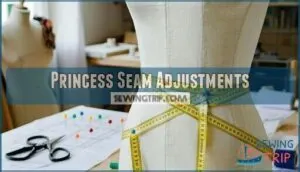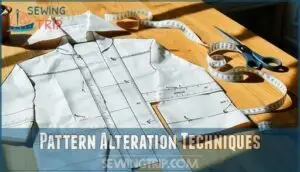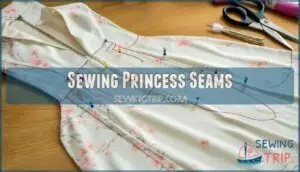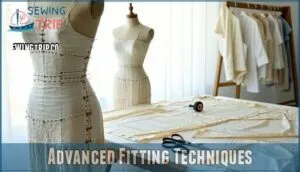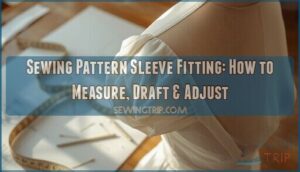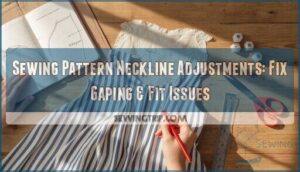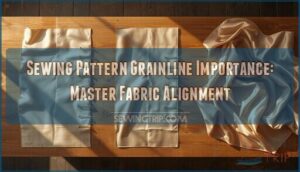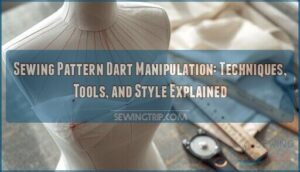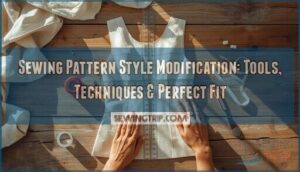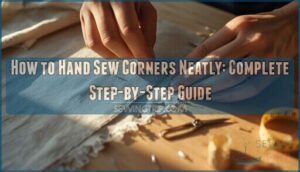This site is supported by our readers. We may earn a commission, at no cost to you, if you purchase through links.

The slash and pivot method can help, and refining curves is vital. You’ll also need to adjust the bust apex for a better fit.
By mastering these techniques, you’ll be able to create a custom-fit garment with ease, and that’s just the beginning of discovering your sewing potential.
Table Of Contents
Key Takeaways
- You’ll likely need to adjust princess seams to fit your body, as they require a customized fit around the bust and waist for a slimming effect and comfortable wear.
- To achieve a perfect fit, you’ll need to identify fit issues, take essential measurements, and adjust the pattern accordingly, using techniques like the slash and pivot method and refining curves.
- You can adjust princess seams by modifying the curve, bust point, or overall volume, and it’s crucial to true the pattern, ensuring a polished, professional look and a flawless fit.
- By mastering pattern alterations and fitting princess seams, you’ll be able to create custom-fit garments with ease, and you can apply these skills to various types of clothing, including tops, dresses, and even maternity wear.
Fitting Princess Seams
You can achieve a flawless fit with princess seams by spotting common issues like tightness, gaping, or misaligned curves.
Achieve a flawless fit with princess seams by spotting common issues early on
Start by measuring key areas and comparing them to your pattern, ensuring the seams match your body’s contours to achieve a proper fit with princess seams.
Identifying Fit Issues
Spotting fit issues in princess seams starts with analyzing your body shape.
Analyze your body shape to spot fit issues in princess seams easily
Use pattern tissue fitting or a muslin sample to check alignment. Focus on bust apex alignment—misalignment can cause gaping or pulling.
Examine for princess seam pulling or gaps and confirm measurement accuracy. Catching these details early guarantees perfect-fitting princess seams before cutting your final fabric.
Essential Measurements
Precision is key when fitting princess seams.
Accurate body measurements help avoid frustration.
Focus on these five essentials:
- Bust Measurement: Around the fullest bust part, parallel to the floor.
- Waist Measurement: Snugly measure the narrowest waist point.
- Hip Measurement: Around hips’ fullest part.
- Shoulder-Apex: Measure shoulder to bust point.
- Size Charts: Compare measurements for accurate princess seam adjustments.
For the bust measurement, consider using a specialized measuring tool.
Common Fit Problems
Garment tightness, bust apex issues, seamline deviation, or princess seam gaping can ruin your fit.
Often, these happen from pattern size discrepancies or misaligned apex points. A muslin fitting highlights problems early, letting you tackle princess seam alterations confidently.
Focus on altering princess seams by adjusting seamlines or refining apex placement for a flawless, professional look. Fitting princess seams takes practice!
Princess Seam Adjustments
You can adjust princess seams to achieve a perfect fit by modifying the curve, bust point, or overall volume.
These precise adjustments guarantee the seams align with your body’s natural shape for a polished, professional look.
Lowering The Apex
Lowering the apex in princess seam fitting caters to gravity considerations and guarantees a smooth, flattering fit for large busts.
Mark the apex first, then reposition it downward using precise pattern drafting skills. True the adjusted seam for balance, keeping the shoulder slope impact in mind.
Understanding and addressing excess fabric under bust is vital for achieving a well-fitted bodice. This princess seam alteration prevents puckering, highlights bust adjustment benefits, and enhances garment comfort by ensuring a smooth fit.
Raising The Apex
If your princess seam bodice feels off, raising the apex fixes it by aligning with your actual bust curve.
Start by marking the apex during muslin fitting.
Cut a box around it on your pattern, slide the section upward, and secure.
This pattern alteration guarantees smooth shoulder slope and neckline impact while achieving perfect apex placement in princess seam fitting.
Full or Small Bust Adjustments
Shifting from raising the apex, let’s tackle bust adjustment methods.
A full bust adjustment adds fabric for depth and volume, preventing muslin fitting issues like tightness.
For smaller busts, remove excess fabric using small bust adjustments.
Keep apex point accuracy in mind, fine-tuning curves.
Test alterations with a muslin before cutting final fabric—pattern grading tips simplify volume distribution techniques for fitting princess seams.
Pattern Alteration Techniques
You’re now ready to learn pattern alteration techniques, which will help you fit princess seams perfectly.
By mastering techniques like truing the pattern, adding or reducing volume, and moving the bust point, you’ll be able to create garments that fit you like a pro.
Truing The Pattern
You’re adjusting your princess seam pattern, now it’s time to true it.
Align notches, make certain grainline truing, and maintain pattern symmetry.
Blend the curve, checking seam allowance, to create a smooth princess seam bodice, making pattern alterations easier and verifying accurate princess seam lines.
Proper truing often requires specialized pattern alteration tools.
Adding or Reducing Volume
You’re now adding or reducing volume in your princess seam pattern, manipulating the seam to achieve desired fabric drape and silhouette shaping, allowing for various design variations to enhance your princess seam bodice or dress through precise pattern alterations.
Remember that you can use slash and spread to add fabric volume.
Moving The Bust Point
To master moving the bust point, you’ll trace the dart curves, redraw the wireline, and adjust the apex alignment, ensuring a perfect fit for your princess seam bodice.
This process may require volume adjustment and seam truing through pattern manipulation and muslin fitting for accurate bust adjustment and apex positioning.
Sewing Princess Seams
You’re now ready to sew your princess seams, and having the right tools and materials is vital.
You’ll need to follow a step-by-step sewing process, and then press and finish your seams to achieve a professional-looking result.
Tools and Materials Needed
You’ll need specific tools to sew princess seams.
- Rulers and Curves
- Marking Tools
- Cutting Supplies
- Pattern Paper
use a French curve ruler and marking pens with invisible tape for accuracy.
A good sewing kit includes essential cutting tools for this purpose, which is crucial for achieving accuracy.
Step-by-Step Sewing Process
You’ll construct the princess seam by sewing the curved edges together, using appropriate stitch settings and pressing methods.
Choose suitable fabric, then cut pieces using precise cutting techniques, a key step in seam construction, as shown in a princess seam tutorial for a princess seam bodice or dress, highlighting the importance of princess seam.
Pressing and Finishing Seams
You’re now pressing and finishing seams, a key step.
Iron seam allowances, then use understitching or topstitching to secure them.
Edge finishing and clean finishing techniques guarantee professional results for your princess seams, enhancing the overall sewing techniques and garment quality with precise ironing and seam curve apex management.
Advanced Fitting Techniques
You’re now ready to move on to advanced fitting techniques, where you’ll learn to customize your pattern for a perfect fit.
By using muslin for fitting and making targeted adjustments, you’ll be able to create garments that flatter your body and make you feel confident.
Customizing The Pattern
You customize the pattern by adjusting drafting basics, considering style variations and design elements.
Personalization tips help create a unique princess seam pattern, allowing for precise princess seam shaping and curve adjustments, ensuring a customized fit through pattern adjustments and grading.
Using muslin mock-ups can refine fit adjustment tests for a better outcome.
Using Muslin for Fitting
You create a muslin sample to test fit adjustments for princess seams, ensuring grainline accuracy and marking adjustments clearly.
Iterative fitting with muslin fabric choice helps reduce waste, allowing precise fit adjustments to pattern pieces for flawless garment fitting.
Proper fitting can be achieved with quality muslin material, which is crucial for flawless garment fitting.
Frequently Asked Questions (FAQs)
Do Princess seams need adjustment?
You’ll likely need to adjust princess seams to fit your body, as they require a customized fit around the bust and waist for a slimming effect and comfortable wear.
Are Princess seams flattering?
You’ll find princess seams incredibly flattering, as they provide a customized fit, skim your body, and create a slimming effect, making them a great choice for various garments.
How do you fit princess seams?
You’ll measure and adjust the princess seam to fit your body, ensuring the curve follows your natural bust line for a customized, slimming effect.
What is a princess seam?
You tackle princess seams like a pro tackling a puzzle, and they’re long, curved seams that offer a slimming effect, providing a customized fit around the bust and waist areas.
How do you fix a princess seam?
You adjust a princess seam by repositioning the curve, truing the pattern, and making adjustments to the apex, ensuring a custom fit that conforms to your individual body shape.
Should I sew princess seams?
You should sew princess seams if you want a custom, slimming fit that conforms to your body shape, as they provide a versatile platform for alterations and customization.
What fabrics work best for princess seams?
You’ll find that fabrics like cotton, wool, and silk work best for princess seams, offering structure and drape for a flattering, custom fit.
Can I use princess seams on pants?
You can use princess seams on pants, but they’re more common in tops and dresses, as they provide a fitted fit around the bust and waist.
Not typically needed in pants.
How do I match stripes on princess seams?
You’ll match stripes on princess seams by carefully planning and aligning patterns, ensuring a seamless and professional finish on your garment.
Are princess seams suitable for maternity wear?
You can adapt princess seams for maternity wear, creating a flattering, flexible fit that accommodates your changing body during pregnancy.
Conclusion
Ironically, mastering pattern alterations fitting princess seams is easier than you think.
You’ll be creating custom-fit garments in no time, using the slash and pivot method, and refining curves.
By following these steps, you’ll achieve a perfect fit with pattern alterations fitting princess seams, making sewing a breeze.


